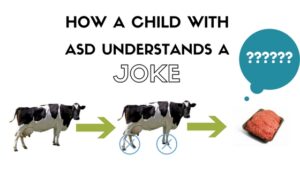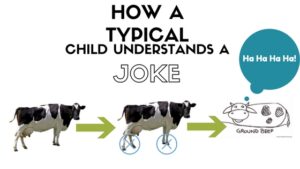Teaching Kids with Autism to Tell and Understand Jokes

What do you call a cow with no legs?? Ground beef!
It’s funny, right? Well maybe it isn’t hysterical to you, but humor is a major part of childhood development. In typical development, the type of jokes a child tells or laughs at can tell you where they are developmentally (i.e. toilet humor versus play on words). Kids with autism often struggle with humor as they are developmentally delayed and very literal and concrete in their understanding of the world.
Why Children with Autism Have Trouble Understanding Jokes
Jokes rely on the use of figurative language and the abstract. (Some individuals with Asperger’s Syndrome can understand and tell jokes as they tend to have a better understanding of word play). Kids on the spectrum also have a limited verbal repertoire, limited background knowledge in general, and struggle with prediction/ cause and effect. In the cow joke, a child on the spectrum may not understand why “ground beef” is funny. The reason for this is because they lack the understanding that a cow without legs would be laying on the ground, beef comes from cows, ground beef is a type of food and not a cow on the ground, which is a play on words. Let’s look at this visually:


If kids on the spectrum struggle with many facets of joke telling, is it a skill worth teaching? Absolutely!
The Social Significance of Kids Telling Jokes
Social Significance refers to the value that a skill has for an individual to be successful in their environment. For many children, especially those included in social situations with typical peers, telling jokes and responding appropriately to jokes is socially significant.
Imagine a group of kids eating together at lunch. One child tells a joke (probably related to toilet humor if they are nine years old). The whole group laughs except the child with autism. Peers will notice the child didn’t laugh and might conclude that the child doesn’t like them or that the child is somehow less intelligent because they didn’t understand the joke. Also, imagine everyone in the group is taking turns telling jokes. When it gets to the child with autism, they don’t know what to say, tell an age- inappropriate joke (either a “baby joke” or an inappropriate adult joke they overheard) or they say something that doesn’t make sense.
What about an adult that tells Knock Knock jokes to other adults? The inability to tell an age-appropriate joke or to respond appropriately (i.e. laugh at the right intensity and volume) is important for helping kids (and adults) on the spectrum to fit in with peers.
The good news is that teaching individuals to tell and respond to jokes can be accomplished without the need to learn figurative language and abstract thinking which can take years to master. In the short term, we can teach our individuals to “fake it until you make it.”
Tips For Teaching Kids with Autism To Tell Jokes
If you want to teach your child with autism tell jokes there are things you can do to help.
- It may be helpful to find jokes that are of interest to the child. For example, if the child likes trains, find some train jokes. If the joke content is of interest to the child, even if they don’t understand the joke, it may motivate them to learn and tell the joke.
- Initially, find jokes with few words. One-liners are good for kids with limited verbal ability. As children gain more language and begin to understand joke-telling, you can increase the complexity (as age-appropriate).
- Keep in mind that jokes that require a lot of back and forth with another person require prerequisite skills such as attending to others and turn taking. If your child does not have these skills, maybe wait to teach a Knock Knock joke.
- A great place to find age-appropriate jokes to teach is to watch same-age peers and listen to the jokes they tell.
- Another method is to test out jokes on siblings or peers before teaching them to ensure they are funny to the targeted age group.
- Find jokes that are relevant to same-age peers, such as jokes related to current events and pop culture references. These jokes may resonant more with peers, giving your child an added “cool” factor.
- Make a visual schedule when initially teaching the child to tell a joke that includes making eye contact, delivering the first line of the joke, waiting for the person to respond, and delivering the punch line (with a smile!). Remember generalization is important! Teach kids to accept different types of responses from the person hearing the joke. For example, teach them that instead of saying “What?” after “What do you call a…” the other person may say “I don’t know” or “I don’t know, what do you call a…” You don’t want them correcting the other person for not responding appropriately; that’s just not funny.
- For kids who quickly grasp the concept of telling jokes and enjoy it, keep in mind that you may have to teach them when it is appropriate to tell jokes (i.e. at recess, not in church), how many jokes to tell before you take a break (it isn’t appropriate to tell jokes non-stop for 10 minutes straight), and not to repeat the same joke to the same person (no one likes a broken record).
- For kids who do understand why the joke is funny, make sure they aren’t explaining the joke to their peer after they tell it.
Tips For Teaching Kids with Autism To Respond To Jokes
It is equally important to teach children to respond appropriately to jokes so don’t skip this part.
- Typically, the appropriate response to a joke is to laugh. Sometimes, though, especially for older kids and adults, it is more appropriate to smile or saying something such as “That’s funny” or “Good one” or “I’ll have to remember that one” instead of laughing.
- It isn’t enough to just teach a child to laugh at a joke; you must also ensure they are laughing appropriately including intensity, volume, and duration of the laugh. I’ve worked with kids that laugh too hard, too loud and too long. Nothing kills the vibe quite like the person in the group that laughs too hard and loud. You might want to practice the different types of laughs such as a chuckle, giggle or gut-busting laugh. 5 point scales are particularly useful for teaching kids to give the appropriate intensity of laugh for the relative “funniness” of the joke.
- It isn’t necessarily a prerequisite that a child understands the joke being told. As long as they laugh at the appropriate time (including intensity, volume, etc.-see above) they can get by just fine in the majority of situations.
- Teach them the reciprocity for jokes. For one liners, it is teaching them to say “What?” after someone says “What do you call a…..” For Knock Knock jokes, it is teaching them to say “Who’s there?”
If you or your child are struggling with social skills and social cues, we can help. Empower Behavioral Health provides a variety of applied behavior analysis (ABA) programs across the state of Texas for individuals with autism. Contact us today to learn more and get started.

